HSH725 Research Literacy: Critical Appraisal of Research Articles
VerifiedAdded on 2023/06/07
|11
|2984
|73
Report
AI Summary
This report presents a critical appraisal of two peer-reviewed research articles: a qualitative study on the mental health of Sudanese refugees and a quantitative study on evidence-informed decision-making among health service managers. The appraisal employs specific tools to assess the validity, results, and applicability of each study. The qualitative study's methodology and ethical considerations are scrutinized, while the quantitative study's design, sample, outcome measurements, and ethical issues are evaluated. Ethical considerations such as informed consent, anonymity, and confidentiality are discussed in relation to both studies. The report concludes by summarizing the significance and limitations of each study, highlighting their potential impact on policy and practice within the healthcare sector. Desklib offers a wealth of resources for students, including similar solved assignments and past papers.
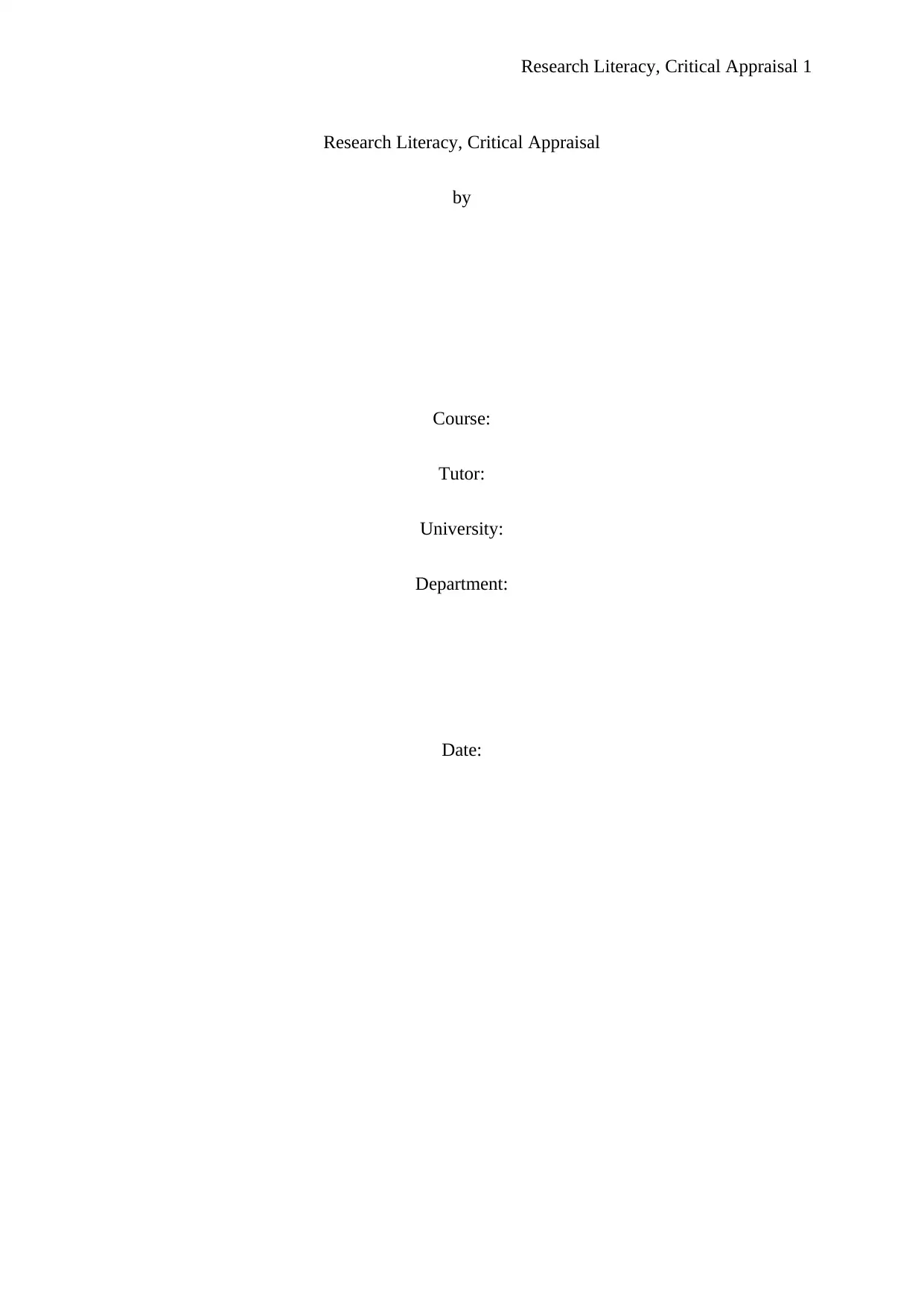
Research Literacy, Critical Appraisal 1
Research Literacy, Critical Appraisal
by
Course:
Tutor:
University:
Department:
Date:
Research Literacy, Critical Appraisal
by
Course:
Tutor:
University:
Department:
Date:
Paraphrase This Document
Need a fresh take? Get an instant paraphrase of this document with our AI Paraphraser
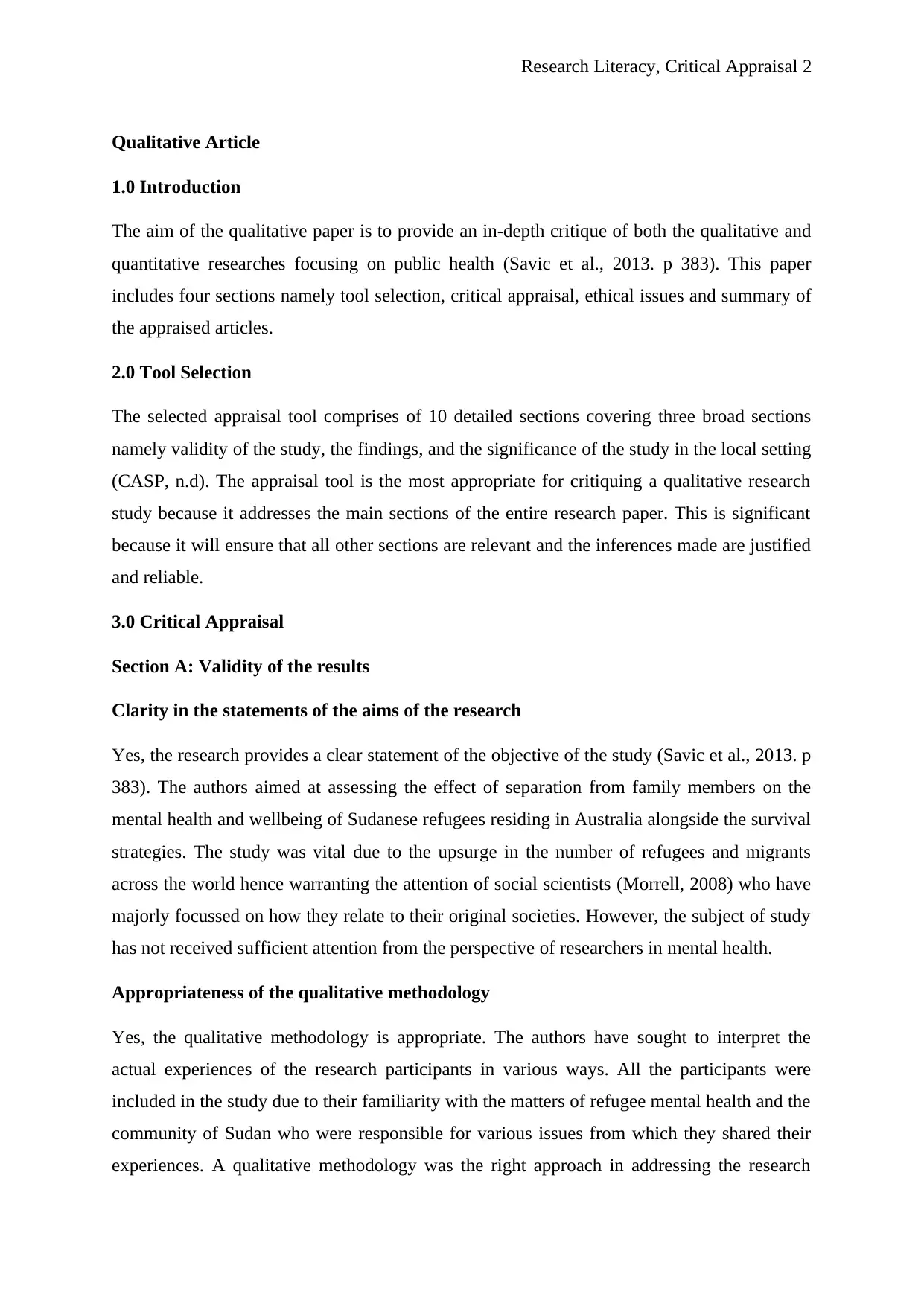
Research Literacy, Critical Appraisal 2
Qualitative Article
1.0 Introduction
The aim of the qualitative paper is to provide an in-depth critique of both the qualitative and
quantitative researches focusing on public health (Savic et al., 2013. p 383). This paper
includes four sections namely tool selection, critical appraisal, ethical issues and summary of
the appraised articles.
2.0 Tool Selection
The selected appraisal tool comprises of 10 detailed sections covering three broad sections
namely validity of the study, the findings, and the significance of the study in the local setting
(CASP, n.d). The appraisal tool is the most appropriate for critiquing a qualitative research
study because it addresses the main sections of the entire research paper. This is significant
because it will ensure that all other sections are relevant and the inferences made are justified
and reliable.
3.0 Critical Appraisal
Section A: Validity of the results
Clarity in the statements of the aims of the research
Yes, the research provides a clear statement of the objective of the study (Savic et al., 2013. p
383). The authors aimed at assessing the effect of separation from family members on the
mental health and wellbeing of Sudanese refugees residing in Australia alongside the survival
strategies. The study was vital due to the upsurge in the number of refugees and migrants
across the world hence warranting the attention of social scientists (Morrell, 2008) who have
majorly focussed on how they relate to their original societies. However, the subject of study
has not received sufficient attention from the perspective of researchers in mental health.
Appropriateness of the qualitative methodology
Yes, the qualitative methodology is appropriate. The authors have sought to interpret the
actual experiences of the research participants in various ways. All the participants were
included in the study due to their familiarity with the matters of refugee mental health and the
community of Sudan who were responsible for various issues from which they shared their
experiences. A qualitative methodology was the right approach in addressing the research
Qualitative Article
1.0 Introduction
The aim of the qualitative paper is to provide an in-depth critique of both the qualitative and
quantitative researches focusing on public health (Savic et al., 2013. p 383). This paper
includes four sections namely tool selection, critical appraisal, ethical issues and summary of
the appraised articles.
2.0 Tool Selection
The selected appraisal tool comprises of 10 detailed sections covering three broad sections
namely validity of the study, the findings, and the significance of the study in the local setting
(CASP, n.d). The appraisal tool is the most appropriate for critiquing a qualitative research
study because it addresses the main sections of the entire research paper. This is significant
because it will ensure that all other sections are relevant and the inferences made are justified
and reliable.
3.0 Critical Appraisal
Section A: Validity of the results
Clarity in the statements of the aims of the research
Yes, the research provides a clear statement of the objective of the study (Savic et al., 2013. p
383). The authors aimed at assessing the effect of separation from family members on the
mental health and wellbeing of Sudanese refugees residing in Australia alongside the survival
strategies. The study was vital due to the upsurge in the number of refugees and migrants
across the world hence warranting the attention of social scientists (Morrell, 2008) who have
majorly focussed on how they relate to their original societies. However, the subject of study
has not received sufficient attention from the perspective of researchers in mental health.
Appropriateness of the qualitative methodology
Yes, the qualitative methodology is appropriate. The authors have sought to interpret the
actual experiences of the research participants in various ways. All the participants were
included in the study due to their familiarity with the matters of refugee mental health and the
community of Sudan who were responsible for various issues from which they shared their
experiences. A qualitative methodology was the right approach in addressing the research
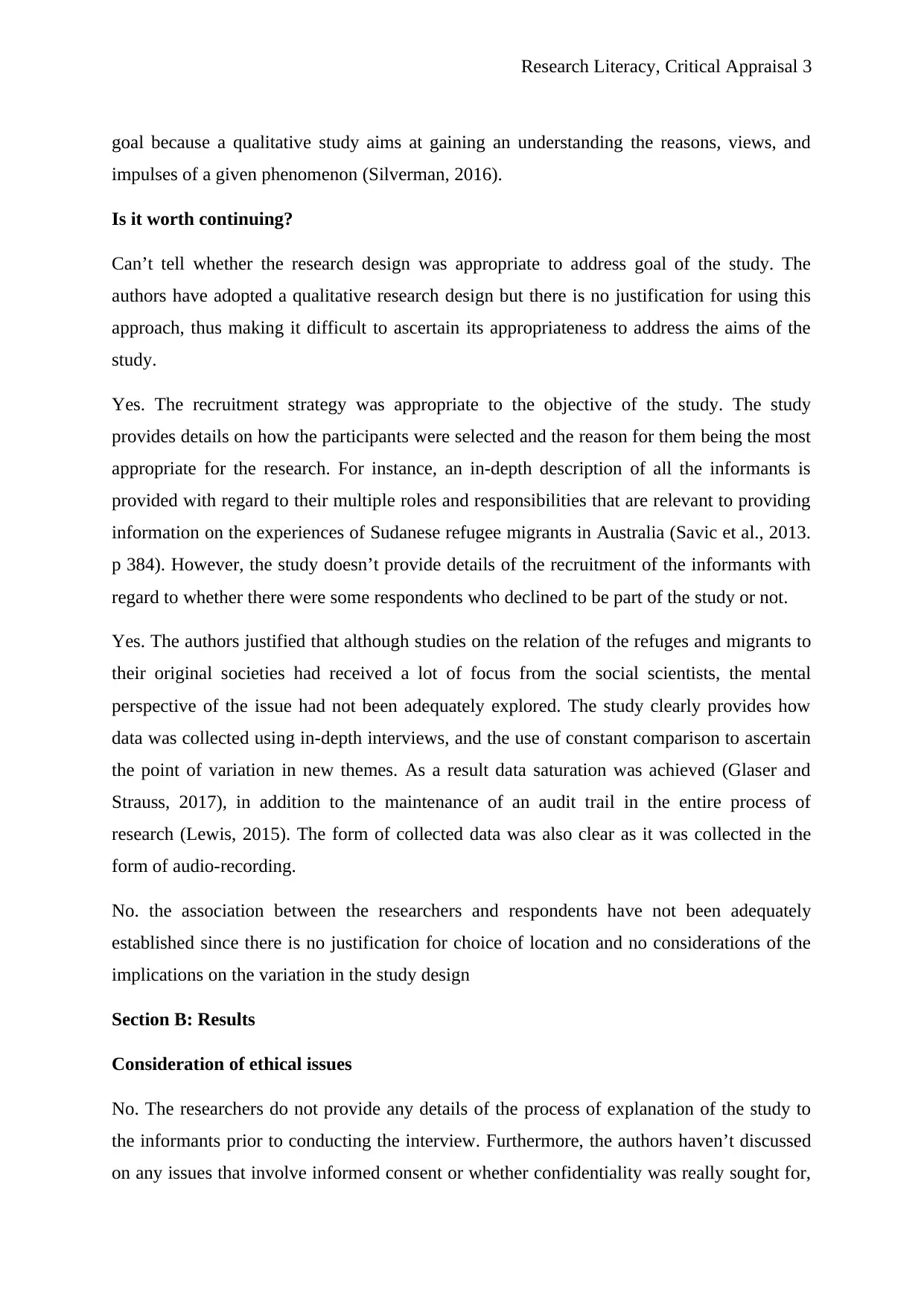
Research Literacy, Critical Appraisal 3
goal because a qualitative study aims at gaining an understanding the reasons, views, and
impulses of a given phenomenon (Silverman, 2016).
Is it worth continuing?
Can’t tell whether the research design was appropriate to address goal of the study. The
authors have adopted a qualitative research design but there is no justification for using this
approach, thus making it difficult to ascertain its appropriateness to address the aims of the
study.
Yes. The recruitment strategy was appropriate to the objective of the study. The study
provides details on how the participants were selected and the reason for them being the most
appropriate for the research. For instance, an in-depth description of all the informants is
provided with regard to their multiple roles and responsibilities that are relevant to providing
information on the experiences of Sudanese refugee migrants in Australia (Savic et al., 2013.
p 384). However, the study doesn’t provide details of the recruitment of the informants with
regard to whether there were some respondents who declined to be part of the study or not.
Yes. The authors justified that although studies on the relation of the refuges and migrants to
their original societies had received a lot of focus from the social scientists, the mental
perspective of the issue had not been adequately explored. The study clearly provides how
data was collected using in-depth interviews, and the use of constant comparison to ascertain
the point of variation in new themes. As a result data saturation was achieved (Glaser and
Strauss, 2017), in addition to the maintenance of an audit trail in the entire process of
research (Lewis, 2015). The form of collected data was also clear as it was collected in the
form of audio-recording.
No. the association between the researchers and respondents have not been adequately
established since there is no justification for choice of location and no considerations of the
implications on the variation in the study design
Section B: Results
Consideration of ethical issues
No. The researchers do not provide any details of the process of explanation of the study to
the informants prior to conducting the interview. Furthermore, the authors haven’t discussed
on any issues that involve informed consent or whether confidentiality was really sought for,
goal because a qualitative study aims at gaining an understanding the reasons, views, and
impulses of a given phenomenon (Silverman, 2016).
Is it worth continuing?
Can’t tell whether the research design was appropriate to address goal of the study. The
authors have adopted a qualitative research design but there is no justification for using this
approach, thus making it difficult to ascertain its appropriateness to address the aims of the
study.
Yes. The recruitment strategy was appropriate to the objective of the study. The study
provides details on how the participants were selected and the reason for them being the most
appropriate for the research. For instance, an in-depth description of all the informants is
provided with regard to their multiple roles and responsibilities that are relevant to providing
information on the experiences of Sudanese refugee migrants in Australia (Savic et al., 2013.
p 384). However, the study doesn’t provide details of the recruitment of the informants with
regard to whether there were some respondents who declined to be part of the study or not.
Yes. The authors justified that although studies on the relation of the refuges and migrants to
their original societies had received a lot of focus from the social scientists, the mental
perspective of the issue had not been adequately explored. The study clearly provides how
data was collected using in-depth interviews, and the use of constant comparison to ascertain
the point of variation in new themes. As a result data saturation was achieved (Glaser and
Strauss, 2017), in addition to the maintenance of an audit trail in the entire process of
research (Lewis, 2015). The form of collected data was also clear as it was collected in the
form of audio-recording.
No. the association between the researchers and respondents have not been adequately
established since there is no justification for choice of location and no considerations of the
implications on the variation in the study design
Section B: Results
Consideration of ethical issues
No. The researchers do not provide any details of the process of explanation of the study to
the informants prior to conducting the interview. Furthermore, the authors haven’t discussed
on any issues that involve informed consent or whether confidentiality was really sought for,
⊘ This is a preview!⊘
Do you want full access?
Subscribe today to unlock all pages.

Trusted by 1+ million students worldwide

Research Literacy, Critical Appraisal 4
assured and maintained. However, the study was ratified by the University of Adelaide
Human Research Ethics Committee.
Rigour of data analysis
Yes. The analysis of data was sufficiently rigorous. The researchers have provided a detailed
description of the process of data analysis using thematic analysis (Srivastava and Thomson,
2009). The authors have also justified it as an appropriate approach for applied or policy
relevant research (Gibbs, 2008). The researchers also devised a thematic framework in which
all the themes were premised on those identified during analysis in addition to the use of
triangulation (Leung, 2015) and an audit trail for reflexivity.
Yes. There is a clear statement of findings because there is adequate discussion in support of
the findings and in contrast to previous studies. Additionally, credibility of the findings have
been discussed and was achieved through analyst triangulation and use of audit trail for
reflexivity.
Section C: Local application of the results
The study provides more information into the current knowledge on matters affecting mental
health of the Sudanese refugees and migrants. Additional research is recommended on effects
of separation on mental health alongside adaptive strategies in varying stages of the
settlement of the refugees (Savic et al., 2013. p 386).
4.0 Ethical Issues
The study doesn’t directly address ethical issues involved in the study. However, the relevant
ethical issues in research include:
Informed consent. All participants are to be well-informed regarding the objective of the
study by being requested to be involved in the research.
Confidentiality. This requires that the participants be assured at the onset of the study the
purpose of the study and what the gathered information will be used for.
Anonymity. The identities of the respondents should remain anonymous throughout the study
to avoid any risks that may result (Fouka and Mantzorou, 2011).
5.0 Summary of the appraisal paper
assured and maintained. However, the study was ratified by the University of Adelaide
Human Research Ethics Committee.
Rigour of data analysis
Yes. The analysis of data was sufficiently rigorous. The researchers have provided a detailed
description of the process of data analysis using thematic analysis (Srivastava and Thomson,
2009). The authors have also justified it as an appropriate approach for applied or policy
relevant research (Gibbs, 2008). The researchers also devised a thematic framework in which
all the themes were premised on those identified during analysis in addition to the use of
triangulation (Leung, 2015) and an audit trail for reflexivity.
Yes. There is a clear statement of findings because there is adequate discussion in support of
the findings and in contrast to previous studies. Additionally, credibility of the findings have
been discussed and was achieved through analyst triangulation and use of audit trail for
reflexivity.
Section C: Local application of the results
The study provides more information into the current knowledge on matters affecting mental
health of the Sudanese refugees and migrants. Additional research is recommended on effects
of separation on mental health alongside adaptive strategies in varying stages of the
settlement of the refugees (Savic et al., 2013. p 386).
4.0 Ethical Issues
The study doesn’t directly address ethical issues involved in the study. However, the relevant
ethical issues in research include:
Informed consent. All participants are to be well-informed regarding the objective of the
study by being requested to be involved in the research.
Confidentiality. This requires that the participants be assured at the onset of the study the
purpose of the study and what the gathered information will be used for.
Anonymity. The identities of the respondents should remain anonymous throughout the study
to avoid any risks that may result (Fouka and Mantzorou, 2011).
5.0 Summary of the appraisal paper
Paraphrase This Document
Need a fresh take? Get an instant paraphrase of this document with our AI Paraphraser
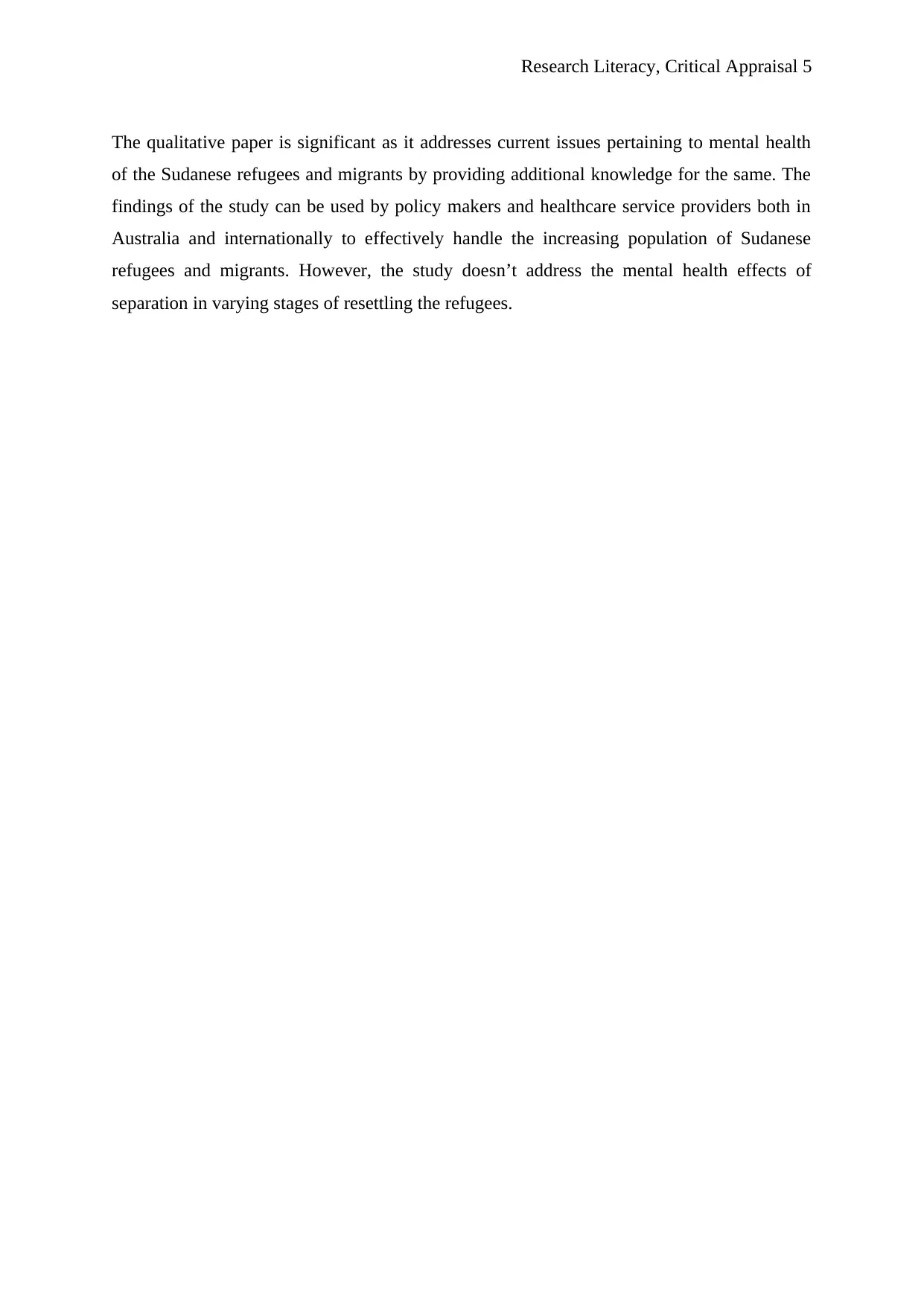
Research Literacy, Critical Appraisal 5
The qualitative paper is significant as it addresses current issues pertaining to mental health
of the Sudanese refugees and migrants by providing additional knowledge for the same. The
findings of the study can be used by policy makers and healthcare service providers both in
Australia and internationally to effectively handle the increasing population of Sudanese
refugees and migrants. However, the study doesn’t address the mental health effects of
separation in varying stages of resettling the refugees.
The qualitative paper is significant as it addresses current issues pertaining to mental health
of the Sudanese refugees and migrants by providing additional knowledge for the same. The
findings of the study can be used by policy makers and healthcare service providers both in
Australia and internationally to effectively handle the increasing population of Sudanese
refugees and migrants. However, the study doesn’t address the mental health effects of
separation in varying stages of resettling the refugees.
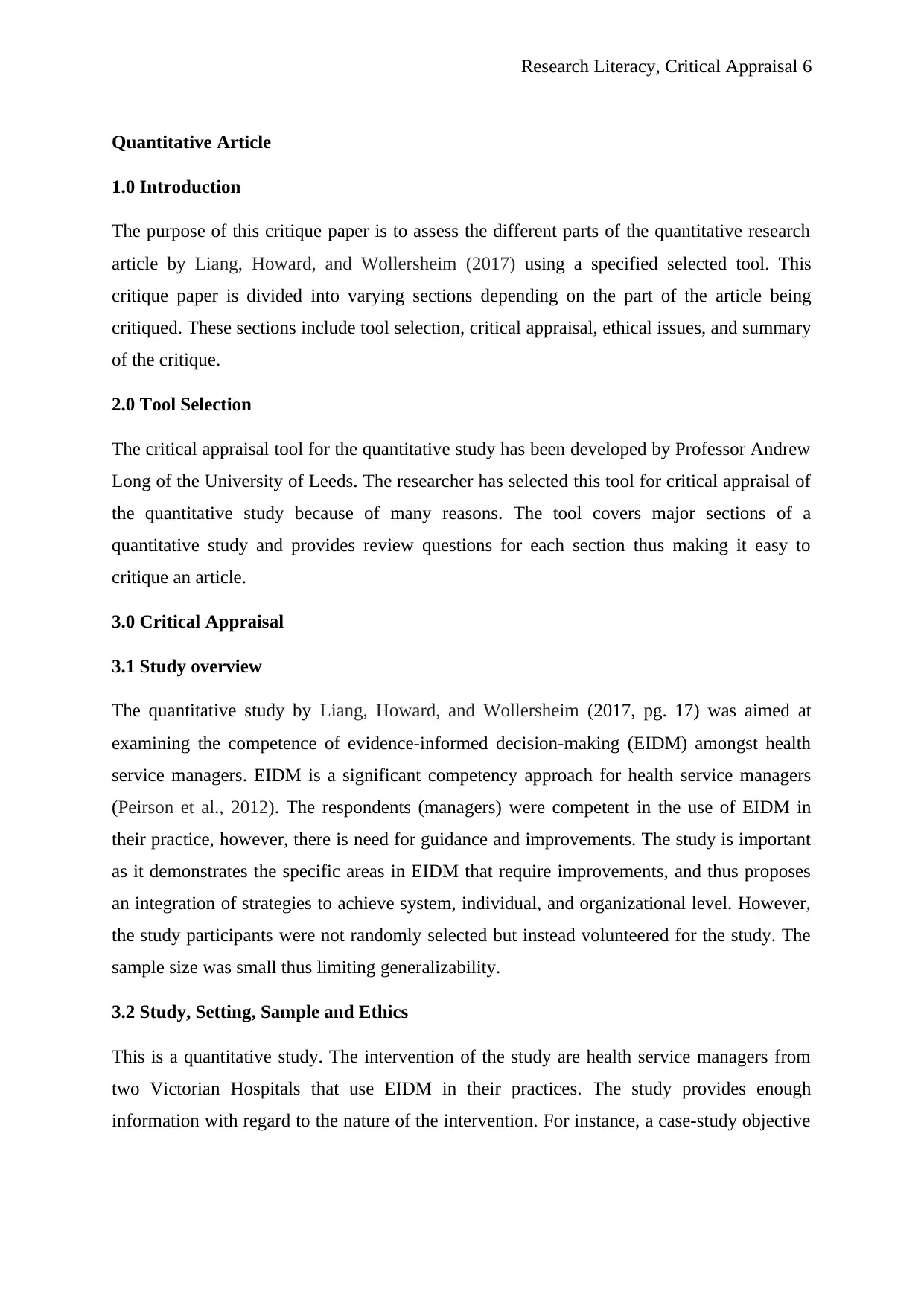
Research Literacy, Critical Appraisal 6
Quantitative Article
1.0 Introduction
The purpose of this critique paper is to assess the different parts of the quantitative research
article by Liang, Howard, and Wollersheim (2017) using a specified selected tool. This
critique paper is divided into varying sections depending on the part of the article being
critiqued. These sections include tool selection, critical appraisal, ethical issues, and summary
of the critique.
2.0 Tool Selection
The critical appraisal tool for the quantitative study has been developed by Professor Andrew
Long of the University of Leeds. The researcher has selected this tool for critical appraisal of
the quantitative study because of many reasons. The tool covers major sections of a
quantitative study and provides review questions for each section thus making it easy to
critique an article.
3.0 Critical Appraisal
3.1 Study overview
The quantitative study by Liang, Howard, and Wollersheim (2017, pg. 17) was aimed at
examining the competence of evidence-informed decision-making (EIDM) amongst health
service managers. EIDM is a significant competency approach for health service managers
(Peirson et al., 2012). The respondents (managers) were competent in the use of EIDM in
their practice, however, there is need for guidance and improvements. The study is important
as it demonstrates the specific areas in EIDM that require improvements, and thus proposes
an integration of strategies to achieve system, individual, and organizational level. However,
the study participants were not randomly selected but instead volunteered for the study. The
sample size was small thus limiting generalizability.
3.2 Study, Setting, Sample and Ethics
This is a quantitative study. The intervention of the study are health service managers from
two Victorian Hospitals that use EIDM in their practices. The study provides enough
information with regard to the nature of the intervention. For instance, a case-study objective
Quantitative Article
1.0 Introduction
The purpose of this critique paper is to assess the different parts of the quantitative research
article by Liang, Howard, and Wollersheim (2017) using a specified selected tool. This
critique paper is divided into varying sections depending on the part of the article being
critiqued. These sections include tool selection, critical appraisal, ethical issues, and summary
of the critique.
2.0 Tool Selection
The critical appraisal tool for the quantitative study has been developed by Professor Andrew
Long of the University of Leeds. The researcher has selected this tool for critical appraisal of
the quantitative study because of many reasons. The tool covers major sections of a
quantitative study and provides review questions for each section thus making it easy to
critique an article.
3.0 Critical Appraisal
3.1 Study overview
The quantitative study by Liang, Howard, and Wollersheim (2017, pg. 17) was aimed at
examining the competence of evidence-informed decision-making (EIDM) amongst health
service managers. EIDM is a significant competency approach for health service managers
(Peirson et al., 2012). The respondents (managers) were competent in the use of EIDM in
their practice, however, there is need for guidance and improvements. The study is important
as it demonstrates the specific areas in EIDM that require improvements, and thus proposes
an integration of strategies to achieve system, individual, and organizational level. However,
the study participants were not randomly selected but instead volunteered for the study. The
sample size was small thus limiting generalizability.
3.2 Study, Setting, Sample and Ethics
This is a quantitative study. The intervention of the study are health service managers from
two Victorian Hospitals that use EIDM in their practices. The study provides enough
information with regard to the nature of the intervention. For instance, a case-study objective
⊘ This is a preview!⊘
Do you want full access?
Subscribe today to unlock all pages.

Trusted by 1+ million students worldwide
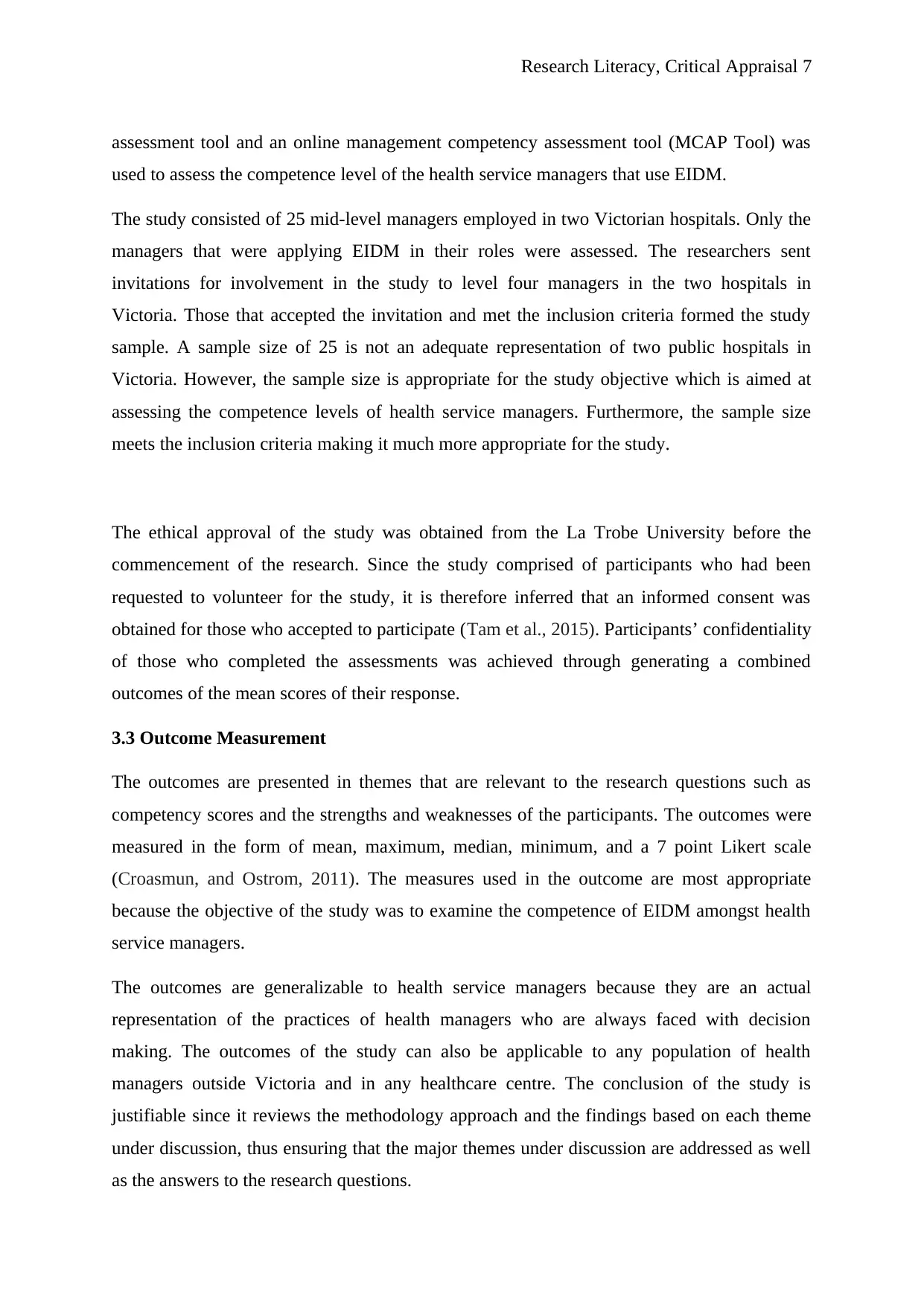
Research Literacy, Critical Appraisal 7
assessment tool and an online management competency assessment tool (MCAP Tool) was
used to assess the competence level of the health service managers that use EIDM.
The study consisted of 25 mid-level managers employed in two Victorian hospitals. Only the
managers that were applying EIDM in their roles were assessed. The researchers sent
invitations for involvement in the study to level four managers in the two hospitals in
Victoria. Those that accepted the invitation and met the inclusion criteria formed the study
sample. A sample size of 25 is not an adequate representation of two public hospitals in
Victoria. However, the sample size is appropriate for the study objective which is aimed at
assessing the competence levels of health service managers. Furthermore, the sample size
meets the inclusion criteria making it much more appropriate for the study.
The ethical approval of the study was obtained from the La Trobe University before the
commencement of the research. Since the study comprised of participants who had been
requested to volunteer for the study, it is therefore inferred that an informed consent was
obtained for those who accepted to participate (Tam et al., 2015). Participants’ confidentiality
of those who completed the assessments was achieved through generating a combined
outcomes of the mean scores of their response.
3.3 Outcome Measurement
The outcomes are presented in themes that are relevant to the research questions such as
competency scores and the strengths and weaknesses of the participants. The outcomes were
measured in the form of mean, maximum, median, minimum, and a 7 point Likert scale
(Croasmun, and Ostrom, 2011). The measures used in the outcome are most appropriate
because the objective of the study was to examine the competence of EIDM amongst health
service managers.
The outcomes are generalizable to health service managers because they are an actual
representation of the practices of health managers who are always faced with decision
making. The outcomes of the study can also be applicable to any population of health
managers outside Victoria and in any healthcare centre. The conclusion of the study is
justifiable since it reviews the methodology approach and the findings based on each theme
under discussion, thus ensuring that the major themes under discussion are addressed as well
as the answers to the research questions.
assessment tool and an online management competency assessment tool (MCAP Tool) was
used to assess the competence level of the health service managers that use EIDM.
The study consisted of 25 mid-level managers employed in two Victorian hospitals. Only the
managers that were applying EIDM in their roles were assessed. The researchers sent
invitations for involvement in the study to level four managers in the two hospitals in
Victoria. Those that accepted the invitation and met the inclusion criteria formed the study
sample. A sample size of 25 is not an adequate representation of two public hospitals in
Victoria. However, the sample size is appropriate for the study objective which is aimed at
assessing the competence levels of health service managers. Furthermore, the sample size
meets the inclusion criteria making it much more appropriate for the study.
The ethical approval of the study was obtained from the La Trobe University before the
commencement of the research. Since the study comprised of participants who had been
requested to volunteer for the study, it is therefore inferred that an informed consent was
obtained for those who accepted to participate (Tam et al., 2015). Participants’ confidentiality
of those who completed the assessments was achieved through generating a combined
outcomes of the mean scores of their response.
3.3 Outcome Measurement
The outcomes are presented in themes that are relevant to the research questions such as
competency scores and the strengths and weaknesses of the participants. The outcomes were
measured in the form of mean, maximum, median, minimum, and a 7 point Likert scale
(Croasmun, and Ostrom, 2011). The measures used in the outcome are most appropriate
because the objective of the study was to examine the competence of EIDM amongst health
service managers.
The outcomes are generalizable to health service managers because they are an actual
representation of the practices of health managers who are always faced with decision
making. The outcomes of the study can also be applicable to any population of health
managers outside Victoria and in any healthcare centre. The conclusion of the study is
justifiable since it reviews the methodology approach and the findings based on each theme
under discussion, thus ensuring that the major themes under discussion are addressed as well
as the answers to the research questions.
Paraphrase This Document
Need a fresh take? Get an instant paraphrase of this document with our AI Paraphraser
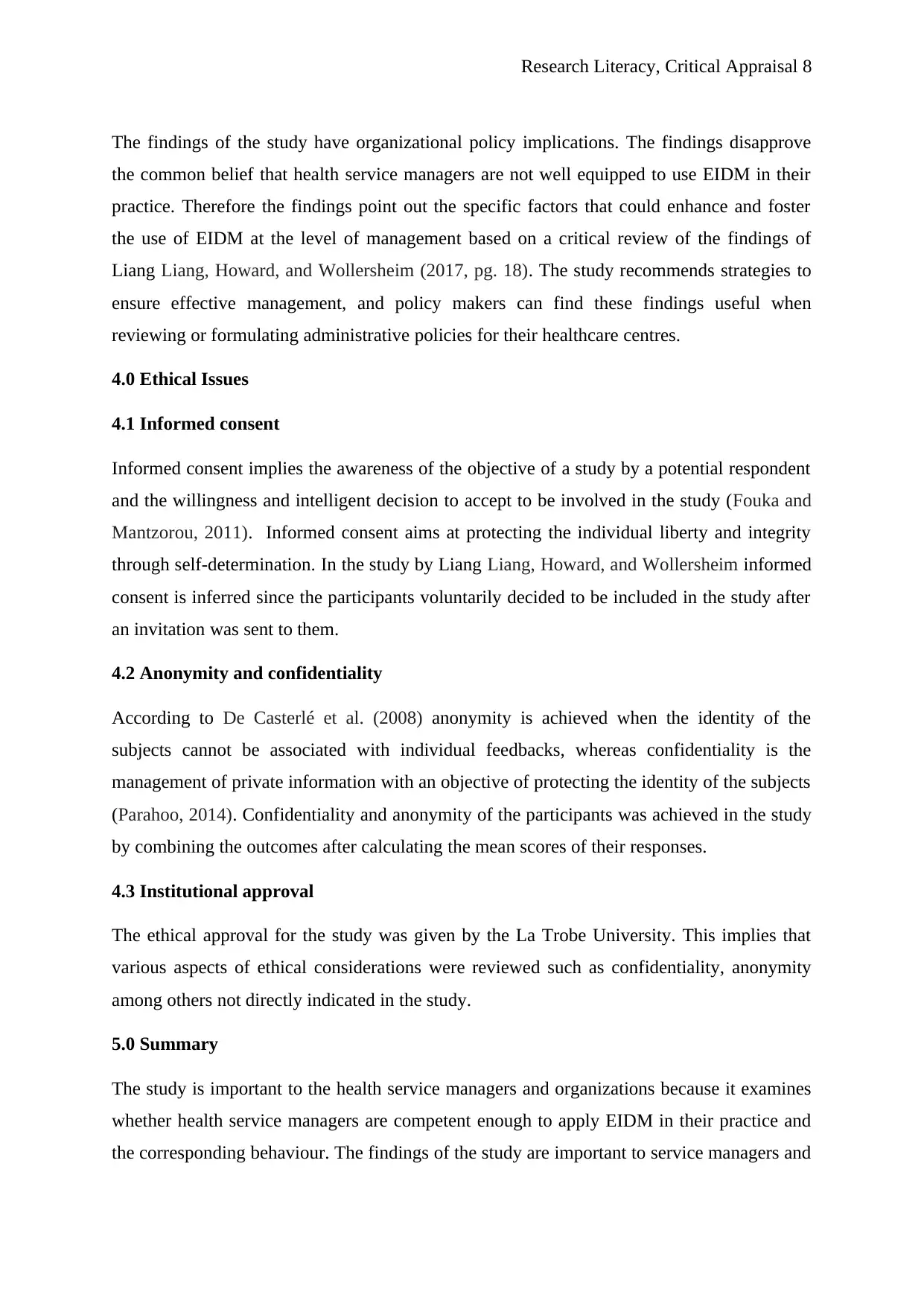
Research Literacy, Critical Appraisal 8
The findings of the study have organizational policy implications. The findings disapprove
the common belief that health service managers are not well equipped to use EIDM in their
practice. Therefore the findings point out the specific factors that could enhance and foster
the use of EIDM at the level of management based on a critical review of the findings of
Liang Liang, Howard, and Wollersheim (2017, pg. 18). The study recommends strategies to
ensure effective management, and policy makers can find these findings useful when
reviewing or formulating administrative policies for their healthcare centres.
4.0 Ethical Issues
4.1 Informed consent
Informed consent implies the awareness of the objective of a study by a potential respondent
and the willingness and intelligent decision to accept to be involved in the study (Fouka and
Mantzorou, 2011). Informed consent aims at protecting the individual liberty and integrity
through self-determination. In the study by Liang Liang, Howard, and Wollersheim informed
consent is inferred since the participants voluntarily decided to be included in the study after
an invitation was sent to them.
4.2 Anonymity and confidentiality
According to De Casterlé et al. (2008) anonymity is achieved when the identity of the
subjects cannot be associated with individual feedbacks, whereas confidentiality is the
management of private information with an objective of protecting the identity of the subjects
(Parahoo, 2014). Confidentiality and anonymity of the participants was achieved in the study
by combining the outcomes after calculating the mean scores of their responses.
4.3 Institutional approval
The ethical approval for the study was given by the La Trobe University. This implies that
various aspects of ethical considerations were reviewed such as confidentiality, anonymity
among others not directly indicated in the study.
5.0 Summary
The study is important to the health service managers and organizations because it examines
whether health service managers are competent enough to apply EIDM in their practice and
the corresponding behaviour. The findings of the study are important to service managers and
The findings of the study have organizational policy implications. The findings disapprove
the common belief that health service managers are not well equipped to use EIDM in their
practice. Therefore the findings point out the specific factors that could enhance and foster
the use of EIDM at the level of management based on a critical review of the findings of
Liang Liang, Howard, and Wollersheim (2017, pg. 18). The study recommends strategies to
ensure effective management, and policy makers can find these findings useful when
reviewing or formulating administrative policies for their healthcare centres.
4.0 Ethical Issues
4.1 Informed consent
Informed consent implies the awareness of the objective of a study by a potential respondent
and the willingness and intelligent decision to accept to be involved in the study (Fouka and
Mantzorou, 2011). Informed consent aims at protecting the individual liberty and integrity
through self-determination. In the study by Liang Liang, Howard, and Wollersheim informed
consent is inferred since the participants voluntarily decided to be included in the study after
an invitation was sent to them.
4.2 Anonymity and confidentiality
According to De Casterlé et al. (2008) anonymity is achieved when the identity of the
subjects cannot be associated with individual feedbacks, whereas confidentiality is the
management of private information with an objective of protecting the identity of the subjects
(Parahoo, 2014). Confidentiality and anonymity of the participants was achieved in the study
by combining the outcomes after calculating the mean scores of their responses.
4.3 Institutional approval
The ethical approval for the study was given by the La Trobe University. This implies that
various aspects of ethical considerations were reviewed such as confidentiality, anonymity
among others not directly indicated in the study.
5.0 Summary
The study is important to the health service managers and organizations because it examines
whether health service managers are competent enough to apply EIDM in their practice and
the corresponding behaviour. The findings of the study are important to service managers and
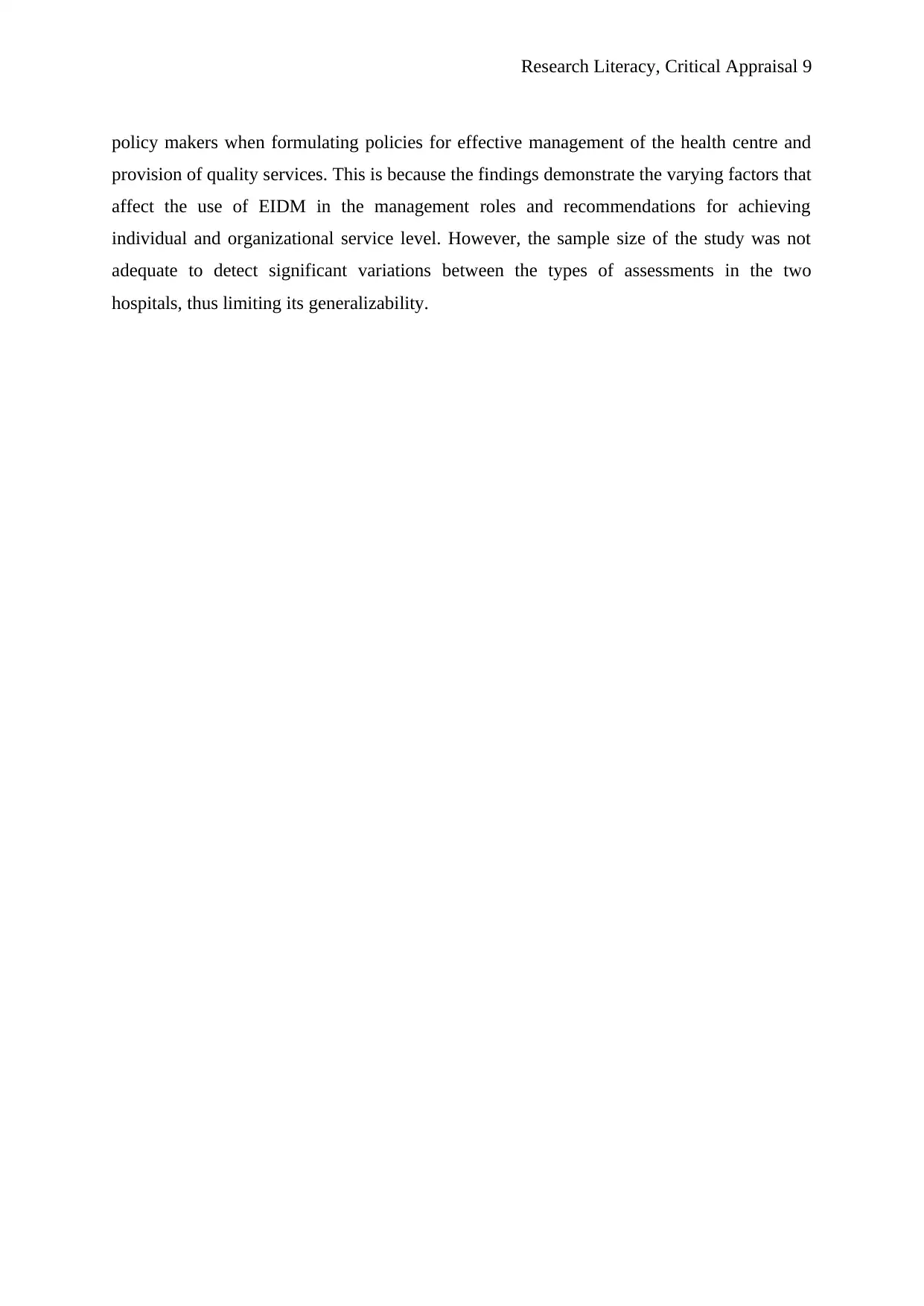
Research Literacy, Critical Appraisal 9
policy makers when formulating policies for effective management of the health centre and
provision of quality services. This is because the findings demonstrate the varying factors that
affect the use of EIDM in the management roles and recommendations for achieving
individual and organizational service level. However, the sample size of the study was not
adequate to detect significant variations between the types of assessments in the two
hospitals, thus limiting its generalizability.
policy makers when formulating policies for effective management of the health centre and
provision of quality services. This is because the findings demonstrate the varying factors that
affect the use of EIDM in the management roles and recommendations for achieving
individual and organizational service level. However, the sample size of the study was not
adequate to detect significant variations between the types of assessments in the two
hospitals, thus limiting its generalizability.
⊘ This is a preview!⊘
Do you want full access?
Subscribe today to unlock all pages.

Trusted by 1+ million students worldwide
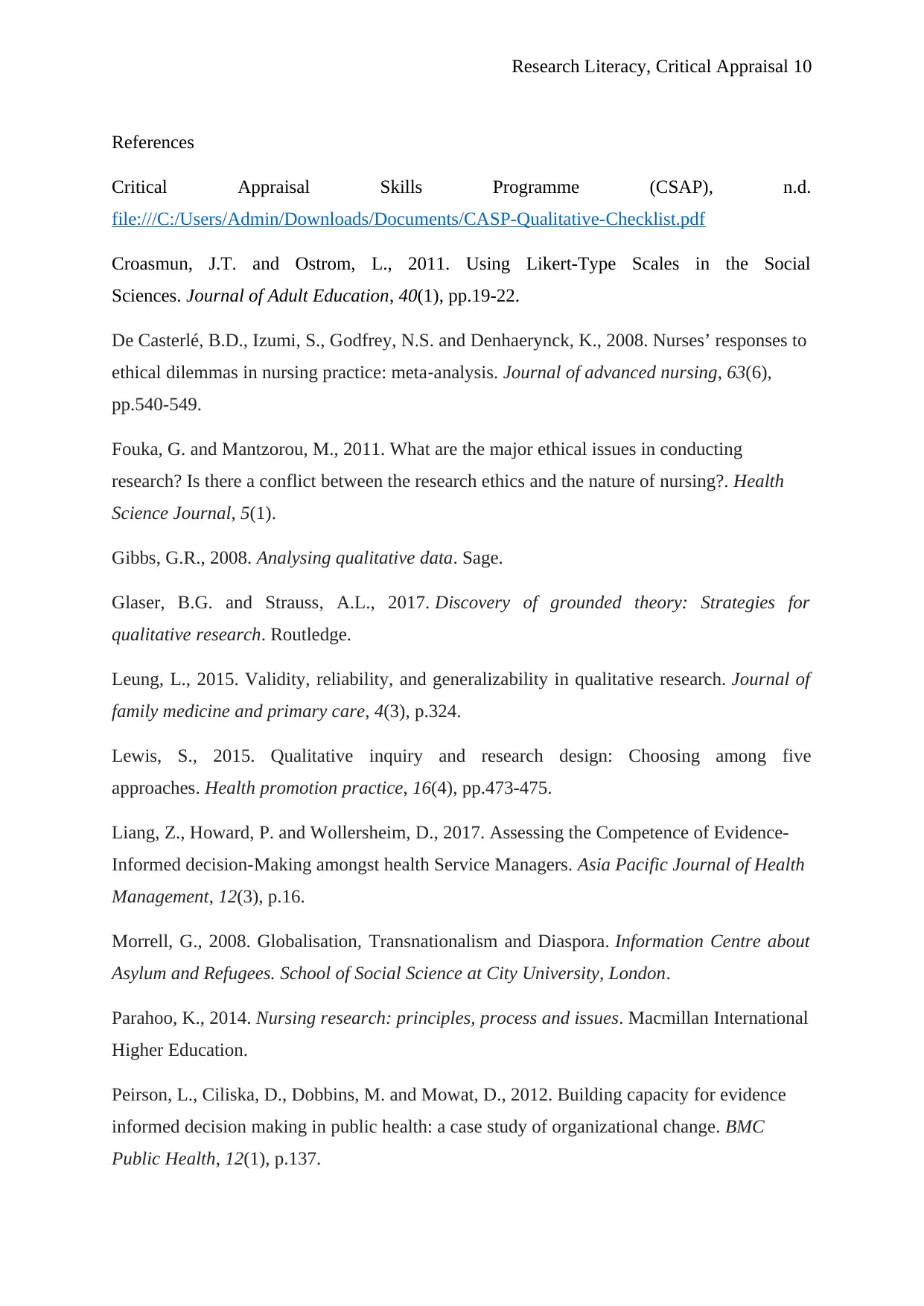
Research Literacy, Critical Appraisal 10
References
Critical Appraisal Skills Programme (CSAP), n.d.
file:///C:/Users/Admin/Downloads/Documents/CASP-Qualitative-Checklist.pdf
Croasmun, J.T. and Ostrom, L., 2011. Using Likert-Type Scales in the Social
Sciences. Journal of Adult Education, 40(1), pp.19-22.
De Casterlé, B.D., Izumi, S., Godfrey, N.S. and Denhaerynck, K., 2008. Nurses’ responses to
ethical dilemmas in nursing practice: meta‐analysis. Journal of advanced nursing, 63(6),
pp.540-549.
Fouka, G. and Mantzorou, M., 2011. What are the major ethical issues in conducting
research? Is there a conflict between the research ethics and the nature of nursing?. Health
Science Journal, 5(1).
Gibbs, G.R., 2008. Analysing qualitative data. Sage.
Glaser, B.G. and Strauss, A.L., 2017. Discovery of grounded theory: Strategies for
qualitative research. Routledge.
Leung, L., 2015. Validity, reliability, and generalizability in qualitative research. Journal of
family medicine and primary care, 4(3), p.324.
Lewis, S., 2015. Qualitative inquiry and research design: Choosing among five
approaches. Health promotion practice, 16(4), pp.473-475.
Liang, Z., Howard, P. and Wollersheim, D., 2017. Assessing the Competence of Evidence-
Informed decision-Making amongst health Service Managers. Asia Pacific Journal of Health
Management, 12(3), p.16.
Morrell, G., 2008. Globalisation, Transnationalism and Diaspora. Information Centre about
Asylum and Refugees. School of Social Science at City University, London.
Parahoo, K., 2014. Nursing research: principles, process and issues. Macmillan International
Higher Education.
Peirson, L., Ciliska, D., Dobbins, M. and Mowat, D., 2012. Building capacity for evidence
informed decision making in public health: a case study of organizational change. BMC
Public Health, 12(1), p.137.
References
Critical Appraisal Skills Programme (CSAP), n.d.
file:///C:/Users/Admin/Downloads/Documents/CASP-Qualitative-Checklist.pdf
Croasmun, J.T. and Ostrom, L., 2011. Using Likert-Type Scales in the Social
Sciences. Journal of Adult Education, 40(1), pp.19-22.
De Casterlé, B.D., Izumi, S., Godfrey, N.S. and Denhaerynck, K., 2008. Nurses’ responses to
ethical dilemmas in nursing practice: meta‐analysis. Journal of advanced nursing, 63(6),
pp.540-549.
Fouka, G. and Mantzorou, M., 2011. What are the major ethical issues in conducting
research? Is there a conflict between the research ethics and the nature of nursing?. Health
Science Journal, 5(1).
Gibbs, G.R., 2008. Analysing qualitative data. Sage.
Glaser, B.G. and Strauss, A.L., 2017. Discovery of grounded theory: Strategies for
qualitative research. Routledge.
Leung, L., 2015. Validity, reliability, and generalizability in qualitative research. Journal of
family medicine and primary care, 4(3), p.324.
Lewis, S., 2015. Qualitative inquiry and research design: Choosing among five
approaches. Health promotion practice, 16(4), pp.473-475.
Liang, Z., Howard, P. and Wollersheim, D., 2017. Assessing the Competence of Evidence-
Informed decision-Making amongst health Service Managers. Asia Pacific Journal of Health
Management, 12(3), p.16.
Morrell, G., 2008. Globalisation, Transnationalism and Diaspora. Information Centre about
Asylum and Refugees. School of Social Science at City University, London.
Parahoo, K., 2014. Nursing research: principles, process and issues. Macmillan International
Higher Education.
Peirson, L., Ciliska, D., Dobbins, M. and Mowat, D., 2012. Building capacity for evidence
informed decision making in public health: a case study of organizational change. BMC
Public Health, 12(1), p.137.
Paraphrase This Document
Need a fresh take? Get an instant paraphrase of this document with our AI Paraphraser
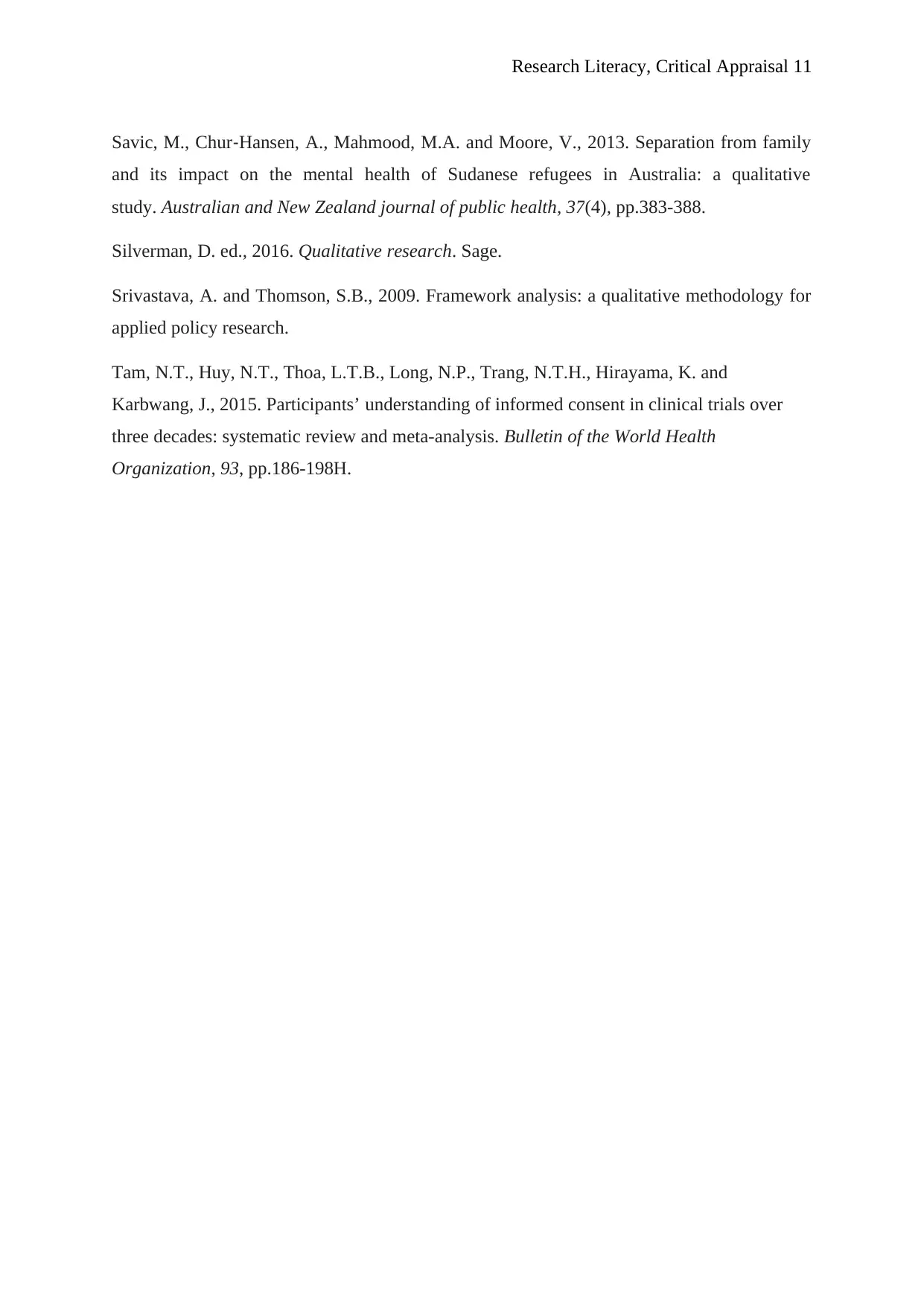
Research Literacy, Critical Appraisal 11
Savic, M., Chur‐Hansen, A., Mahmood, M.A. and Moore, V., 2013. Separation from family
and its impact on the mental health of Sudanese refugees in Australia: a qualitative
study. Australian and New Zealand journal of public health, 37(4), pp.383-388.
Silverman, D. ed., 2016. Qualitative research. Sage.
Srivastava, A. and Thomson, S.B., 2009. Framework analysis: a qualitative methodology for
applied policy research.
Tam, N.T., Huy, N.T., Thoa, L.T.B., Long, N.P., Trang, N.T.H., Hirayama, K. and
Karbwang, J., 2015. Participants’ understanding of informed consent in clinical trials over
three decades: systematic review and meta-analysis. Bulletin of the World Health
Organization, 93, pp.186-198H.
Savic, M., Chur‐Hansen, A., Mahmood, M.A. and Moore, V., 2013. Separation from family
and its impact on the mental health of Sudanese refugees in Australia: a qualitative
study. Australian and New Zealand journal of public health, 37(4), pp.383-388.
Silverman, D. ed., 2016. Qualitative research. Sage.
Srivastava, A. and Thomson, S.B., 2009. Framework analysis: a qualitative methodology for
applied policy research.
Tam, N.T., Huy, N.T., Thoa, L.T.B., Long, N.P., Trang, N.T.H., Hirayama, K. and
Karbwang, J., 2015. Participants’ understanding of informed consent in clinical trials over
three decades: systematic review and meta-analysis. Bulletin of the World Health
Organization, 93, pp.186-198H.
1 out of 11
Related Documents
Your All-in-One AI-Powered Toolkit for Academic Success.
+13062052269
info@desklib.com
Available 24*7 on WhatsApp / Email
![[object Object]](/_next/static/media/star-bottom.7253800d.svg)
Unlock your academic potential
Copyright © 2020–2026 A2Z Services. All Rights Reserved. Developed and managed by ZUCOL.





